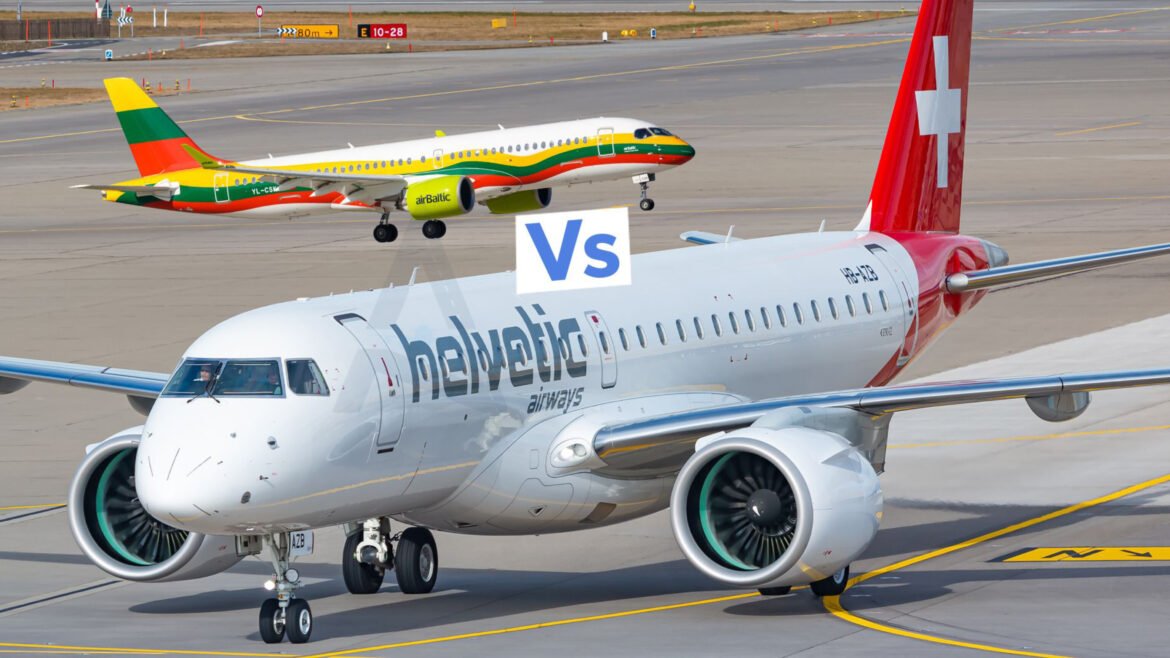The competition between the Airbus A220 and the Embraer E2 series has intensified in recent years, as both aircraft families target the same niche for efficient, short- to medium-haul flights. Airlines worldwide are considering these models for their regional and domestic routes, seeking the best fit for operational needs. Each aircraft has its own set of strengths, and understanding the key differences between the A220 and E2 is crucial for carriers looking to optimize their fleet.
Here, we explore five key areas where the Airbus A220 and Embraer E2 differ, highlighting the advantages of each model and how they align with the operational goals of airlines.
1. Fuel Efficiency and Operating Costs
When it comes to fuel efficiency and operating costs, both the Airbus A220 and the Embraer E2 are designed to be highly efficient, with modern materials and engines that reduce fuel consumption. However, the A220 tends to have a slight edge in overall fuel efficiency.
The A220-300, in particular, benefits from Pratt & Whitney PW1500G engines, which provide fuel savings of up to 20% compared to older regional jets. This can lead to significant savings over time, especially on high-frequency short to medium routes. Furthermore, the A220’s lightweight composite structure contributes to its low operating costs, making it a strong choice for carriers focused on efficiency.
In comparison, the Embraer E2 series is also designed for fuel efficiency, with its Pratt & Whitney GTF engines offering a 16-18% reduction in fuel consumption. While not quite as fuel-efficient as the A220 in long-haul operations, the E2 still represents a significant step forward in efficiency compared to older aircraft models. This makes the E2 a competitive option for airlines prioritizing operating costs on shorter regional routes.
2. Passenger Capacity and Cabin Comfort
Passenger capacity and cabin comfort are vital factors in determining the success of regional and domestic flights. Airlines need to offer a comfortable experience for passengers while optimizing the number of seats to maximize profitability.
The Airbus A220 is slightly larger in capacity. The A220-300 can accommodate up to 160-180 passengers, depending on the configuration, while the A220-100 can carry around 130-140 passengers. Its wide cabin design, with a 2-3 seating arrangement, offers a more spacious feel compared to its competitors, allowing for wider seats and larger overhead bins. The larger cabin also contributes to the aircraft’s quieter interior, which enhances passenger comfort on longer flights.
On the other hand, the Embraer E2 series—including the E190-E2 and E195-E2—can carry between 97 and 130 passengers, with a seating configuration typically of 2-2. While the E2 offers a high level of comfort, especially with its quiet cabin and modern amenities, it has a smaller seating capacity compared to the A220. For airlines looking to maximize seat density on higher-traffic routes, the A220 may be a more attractive option.
3. Range and Route Flexibility
Range is another crucial factor when choosing an aircraft for regional and domestic operations. The range of an aircraft directly influences its route flexibility and the ability to serve longer regional sectors or even short-haul international flights.
The Airbus A220 offers greater range compared to the Embraer E2 series. The A220-300 has a range of approximately 3,400 nautical miles, which allows it to operate on longer regional flights or even some longer domestic routes. The smaller A220-100 can cover around 3,100 nautical miles, making it ideal for medium-haul routes.
In contrast, the Embraer E2 models—specifically the E195-E2—have a slightly more limited range of around 2,600 nautical miles, which may restrict their use for longer regional flights or international routes. While the E2 can handle a wide range of short to medium-haul sectors efficiently, it doesn’t offer the same flexibility as the A220 for longer routes.
4. Maintenance and Reliability
Maintenance efficiency and aircraft reliability play a critical role in determining the long-term cost-effectiveness of an aircraft. Airlines seek models that offer reduced downtime, lower maintenance costs, and improved operational efficiency.
Both the Airbus A220 and the Embraer E2 series benefit from modern engineering, with a focus on ease of maintenance and high reliability. The A220 benefits from the use of advanced composites and new generation engines, which contribute to lower maintenance requirements and longer intervals between overhauls. In terms of operational reliability, the A220 has a strong track record since its entry into service, and its parts and systems are designed to minimize unscheduled maintenance.
Similarly, the Embraer E2 series also incorporates the latest technology, with the use of composite materials and modern systems to improve durability and reduce the frequency of maintenance checks. The E2’s redundant systems and state-of-the-art cockpit ensure high reliability, even on shorter regional routes. Embraer’s focus on high reliability has earned the E2 series a reputation for being an efficient and low-maintenance aircraft, which is crucial for high-frequency operations.
5. Environmental Impact and Sustainability
With sustainability increasingly at the forefront of the aviation industry, both the Airbus A220 and the Embraer E2 are designed with environmental considerations in mind.
The A220 stands out for its fuel efficiency and reduced carbon emissions, with up to 20% less fuel consumption compared to older aircraft types. The A220 is also quieter, reducing noise pollution around airports and communities. These factors make the A220 an attractive option for airlines that are focusing on reducing their environmental footprint and adhering to stricter emissions regulations.
Similarly, the Embraer E2 series is designed with sustainability in mind, offering low fuel consumption, reduced emissions, and a quieter operation compared to older regional jets. The E195-E2, in particular, offers 24% better fuel efficiency than its predecessor, the E195, and is also equipped with the latest generation engines that help reduce noise and CO2 emissions.
Conclusion
Both the Airbus A220 and the Embraer E2 series represent significant advancements in regional jet technology, each offering distinct advantages depending on an airline’s needs. The A220 excels in terms of fuel efficiency, passenger capacity, and range flexibility, making it a strong choice for airlines looking to operate medium-haul routes with higher seating capacity. Meanwhile, the Embraer E2 series is a highly efficient and reliable option, particularly for airlines operating shorter regional routes where smaller capacity and lower operating costs are more important.
Ultimately, the choice between the A220 and the E2 will depend on an airline’s specific operational requirements, route network, and environmental goals. Both aircraft families offer modern, sustainable solutions, but each comes with its own set of strengths that may make one more suitable than the other for particular market needs.

